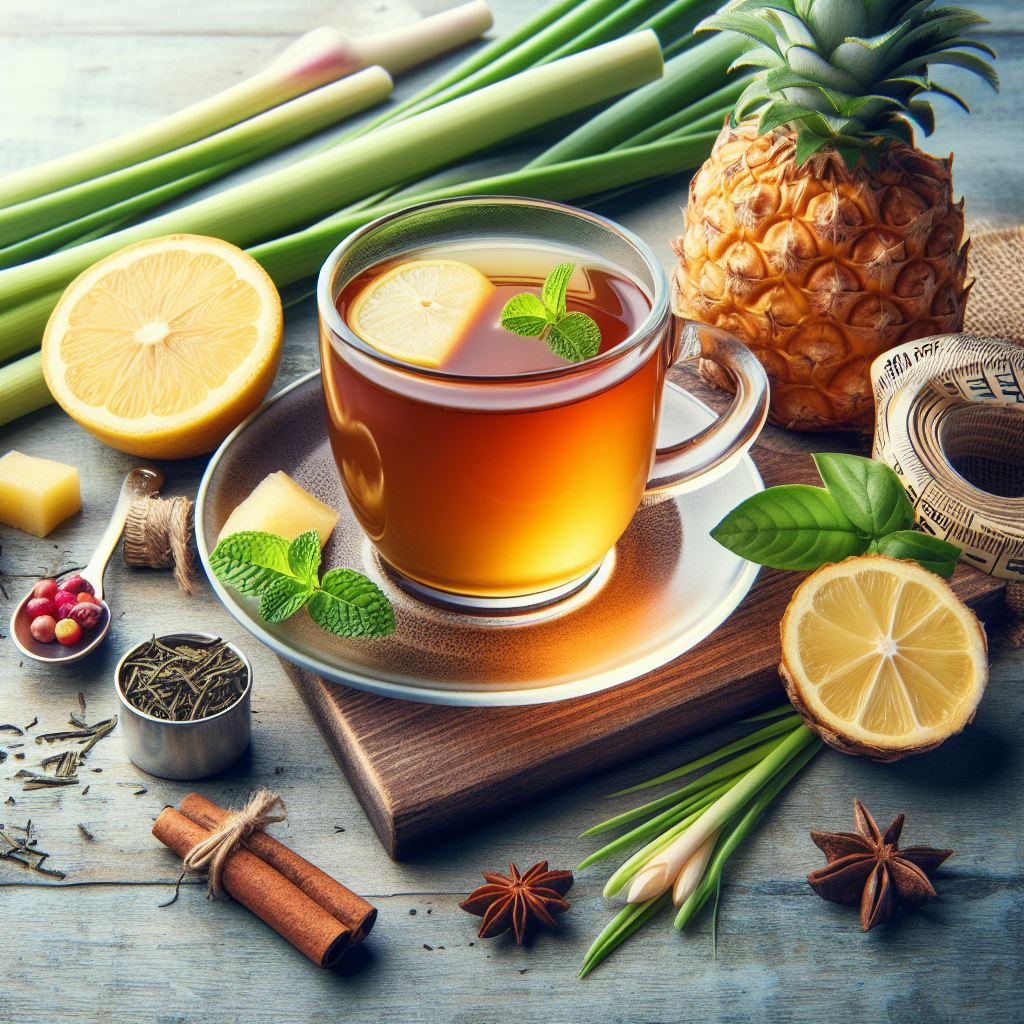Welcome back to Tea 101, the series where we explore the fascinating world of tea. In this instalment, we will focus on green tea, another one of the most popular and versatile types of tea. Whether you are a seasoned tea lover or a curious beginner, you will find something new and interesting to learn in this comprehensive guide about green tea!

What is Green Tea?
Green tea is a type of tea that is made from the leaves and buds of the Camellia sinensis plant, the same plant that produces black, oolong, and white teas. However, unlike these other types of tea, green tea does not undergo oxidation, a process that changes the color and flavor of the tea leaves. Instead, green tea leaves are quickly heated or steamed after harvesting to prevent oxidation and preserve their natural green color and fresh flavor.
Green tea originated in China, where it has been cultivated and consumed for thousands of years. It is also widely enjoyed in Japan, Korea, and other Asian countries, as well as around the world. Green tea has a long history of being associated with health benefits, cultural traditions, and a guide for spiritual practices.
History and Origins of Green Tea

According to legend, green tea was discovered by accident by Emperor Shennong in 2737 BC, when some tea leaves fell into his boiling water. He was intrigued by the pleasant aroma and taste of the infusion and decided to drink it regularly. He also noticed that it had medicinal properties, such as curing headaches and improving digestion. Discover more about Emperor Shennong’s Tea discovery and read The Amazing Origins of Tea: How Tea Was Invented by a Mythical Chinese God
The earliest written records of green tea date back to the 8th century AD, when a Buddhist monk named Lu Yu wrote The Classic of Tea, a comprehensive guide on the cultivation, processing, preparation, and appreciation of tea. Lu Yu described green tea as “the froth of the liquid jade” and praised its benefits for the mind and body.
Green tea was also introduced to Japan in the 8th century by Buddhist monks who traveled to China to study. They brought back tea seeds and planted them in Japan, where they developed their own varieties and styles of green tea. The Japanese also refined the art of the tea ceremony, a ritualized way of preparing and serving green tea that emphasizes harmony, respect, purity, and tranquility.
Types and Varieties of Green Tea
There are many types and varieties of green tea available today, each with its own characteristics, flavors, and brewing methods. You can find some of the most common types of green tea and some quality recommendations in the guide below.
These are just some examples of the many types of green tea that you can try. You can also find flavored or blended green teas that have added ingredients such as fruits, flowers, herbs, or spices to enhance their taste and aroma.
Matcha
This is a powdered green tea that is whisked with hot water to create a frothy drink. Matcha is made from shade-grown tea leaves that are finely ground. It has a vibrant green color and a rich, creamy taste. Matcha is often used in the Japanese tea ceremony, as well as in cooking and baking.
- Ippodo Tea Sayaka: Rich Matcha Tea
Ippodo matcha first: Sayaka is accessible, rich, and smooth, with just a hint of astringency. Satisfying for beginners and matcha fans alike. - Jade Leaf Organic Ceremonial Grade Matcha Green Tea Powder
Premium first harvest tea leaves picked and carefully crafted into this Teahouse Edition Ceremonial Matcha; an authentic Japanese matcha giving it a delightful, smooth flavor profile best appreciated when sipping as traditionally prepared tea.
Sencha
This is the most common type of green tea in Japan. Sencha is made from steamed and rolled tea leaves that are dried and sorted by grade. It has a bright green color and a grassy, vegetal flavor. Sencha is usually brewed with hot but not boiling water for a short time.
- FGO Organic Sencha Loose Leaf Tea
Organic Sencha tea imported from Japan. Enjoy this gentle uplift of authentic Japanese Sencha Green Tea. Honed from centuries of tea-making traditions, sencha is known for its steamed leaves, a process that helps to prevent oxidation and lock in its fresh green color. - Harney & Sons Japanese Sencha Caffeinated Green Tea Bag
This Sencha is a very fine one from the central Shizuoka province, and can be found in many homes in Tokyo. It is a pleasant and approachable green tea a fine choice for everyday with the convenience of tea bags.
Gunpowder
This is a type of green tea from China that is named after its appearance. Gunpowder is made from pan-fired and rolled tea leaves that form small pellets that resemble gunpowder. It has a dark green color and a smoky, nutty flavor. Gunpowder is usually brewed with boiling water for a longer time.
- Numi Organic Gunpowder Green Tea Pearls
Full-Bodied Flavor: Within hours of being plucked, this whole leaf organic green tea is gently steamed and then rolled into small tight pearls; When steeped, the leaves unfurl, releasing a well-rounded, full-bodied flavor - Davidson’s Organics, Gunpowder Green Loose Leaf Tea
From the farms of India, Davidson’s Gunpowder Green (Loose Leaf) brews mellow and layered, with a deep, smoky flavor profile.
Dragonwell
This is another type of green tea from China that is also known as Longjing. Dragonwell is made from pan-fired and flattened tea leaves that have a distinctive shape resembling a dragon’s well. It has a light green color and a sweet, floral flavor. Dragonwell is usually brewed with slightly cooler water for a shorter time.
- Silk Road Organic Fair Trade Dragon Well Green Tea
Dragon Well “Longjing”, golden-green leaves, wok-fired to rich nutty aroma & toasty flavor. An organic artisan crafted leaf, min-milled leaf for best flavor & aroma in a teabag. - Patenger: Dragon Well Green Tea – Lung Ching – Longjing Loose Leaf
A celebrated Chinese dragon well tea. The flat green tea leaves have a toasty chestnut aroma. The taste is sweet, nutty and aromatic and it has a smooth, sweet vegetable and apricot aftertaste. It also has a cooling effect.
Health Benefits of Green Tea
Green tea has been praised for its health benefits for centuries. Modern research has confirmed some of these benefits and suggested some more. Here is a guide to some of the health benefits associated with consuming green tea:
- Antioxidant properties: Green tea contains polyphenols, especially catechins such as epigallocatechin gallate (EGCG), that have antioxidant effects. Antioxidants help protect the cells from damage caused by free radicals, which are unstable molecules that can cause aging and disease.
- Weight loss benefits: Green tea may help boost metabolism and fat burning by increasing energy expenditure and enhancing the effects of certain hormones that regulate appetite and fat storage. Green tea may also reduce the absorption of carbohydrates and fats in the digestive tract.
- Cardiovascular benefits: Green tea may help lower blood pressure and cholesterol levels by improving blood vessel function and reducing inflammation. Green tea may also prevent the formation of blood clots that can cause heart attacks and strokes.
- Mental well-being benefits: Green tea may help improve mood, alertness, and cognitive function by stimulating the production of certain neurotransmitters such as dopamine and serotonin. Green tea may also protect the brain from degeneration and dementia by preventing oxidative stress and inflammation.
These are some of the health benefits that have been supported by scientific studies. However, more research is needed to guide and confirm the extent and mechanisms of these green tea benefits. It is also important to note that green tea is not a miracle cure for any disease or condition, and that it should be consumed in moderation and as part of a balanced diet and lifestyle.
Brewing Techniques and Tips

To enjoy the best flavor and aroma of green tea, you need to brew it properly. Here is another guide with some general steps and tips on how to brew green tea:
1. Choose Your Green Tea:
Depending on your preference, you can choose loose leaf green tea or green tea bags. Loose leaf green tea tends to have more flavor and freshness than tea bags, but it also requires more equipment and measurement. Tea bags are more convenient and easy to use, but they may contain lower quality or stale tea leaves.
2. Heat Your Water:
As a general guide, the ideal water temperature for brewing green tea is between 160°F and 180°F (70°C and 80°C). You can use a thermometer to measure the temperature, or you can simply boil the water and let it cool down for a few minutes. Avoid using boiling water, as it can scorch the tea leaves and make the tea bitter.
3. Measure Your Tea:
The ideal amount of green tea to use depends on the type and strength of the tea, as well as your personal taste. A general rule of thumb is to use 2 grams (about 1 teaspoon) of loose leaf green tea or 1 tea bag per 6 ounces (180 ml) of water. You can adjust this ratio according to your preference.
4. Steep Your Tea
The ideal steeping time for green tea also depends on the type and quality of the tea, as well as your desired flavor. As a general guide, you can steep green tea for 1 to 3 minutes. Feel free to check the color and aroma of the tea to determine when it is ready. Be aware of oversteeping though, as it can make the tea bitter and astringent.
5. Enjoy Your Tea
Once your tea is ready, you can pour it into a cup and enjoy it. You can also add sweeteners, milk, lemon, or other ingredients to enhance or modify the taste of your tea. However, purists may prefer to drink green tea plain, as adding other ingredients may mask or alter its natural flavor.
These are some basic steps and tips as a guide for brewing green tea. You can also experiment with different types of green tea, water temperatures, steeping times, and additives to find your perfect cup of green tea.
Flavor Profiles and Pairings
Green tea has a wide range of flavor profiles, depending on the type, origin, processing, and brewing method of the tea. Some common descriptors for green tea flavors are:
- Grassy: This refers to a fresh, herbal, or hay-like flavor that is common in steamed green teas such as sencha or matcha.
- Vegetal: This refers to a savory, earthy, or vegetable-like flavor that is common in pan-fired green teas such as gunpowder or dragonwell.
- Nutty: This refers to a roasted, toasted, or almond-like flavor that is common in some pan-fired or baked green teas such as genmaicha or hojicha.
- Floral: This refers to a sweet, fragrant, or blossom-like flavor that is common in some high-quality or flavored green teas such as jasmine or rose.
- Fruity: This refers to a citrusy, berry-like, or tropical flavor that is common in some flavored or blended green teas such as lemon or mango.
These are some examples of the different flavor profiles of green tea. You can also find other nuances and subtleties in each type of green tea that make it unique and enjoyable.
To enhance your green tea experience, you can also pair it with food that complements its flavor profile. Here are some suggestions for food pairings with green tea:
- Grassy green teas: These go well with light desserts such as cakes, cookies, or fruit salads. They also pair well with sushi, sashimi, or steamed vegetables.
- Vegetal green teas: These go well with savory dishes such as noodles, rice, or stir-fries. They also pair well with cheese, nuts, or crackers.
- Nutty green teas: These go well with baked goods such as breads, muffins, or pastries. They also pair well with chocolate, caramel, or honey.
- Floral green teas: These go well with delicate desserts such as macarons, meringues, or custards. They also pair well with salads, sandwiches, or yogurt.
- Fruity green teas: These go well with tropical desserts such as coconut, pineapple, or mango. They also pair well with spicy dishes such as curry, chili, or tacos.
These are just some examples of food pairings with green tea. You can also experiment with your own combinations and preferences to find your ideal match.
Green Tea Traditions and Ceremonies

Green tea is not only a beverage, but also a cultural and spiritual symbol. There are many traditions and ceremonies associated with green tea, especially in Asia, where it has been revered for centuries.
One of the most famous and elaborate tea ceremonies is the Japanese tea ceremony, also known as chanoyu or sado. This is a ritualized way of preparing and serving green tea, usually matcha, in a serene and elegant setting. The tea ceremony involves a host and one or more guests, who follow a series of steps and etiquette to create a harmonious and mindful atmosphere. The tea ceremony is influenced by Zen Buddhism and reflects the principles of harmony, respect, purity, and tranquility.
Another example of a green tea tradition is the Chinese gongfu tea ceremony, also known as gongfu cha or kung fu tea. This is a more casual and flexible way of brewing and enjoying green tea, usually loose leaf, in a small teapot and cups. The gongfu tea ceremony involves multiple infusions of the same tea leaves, each with different steeping times and temperatures to extract different flavors and aromas. The gongfu tea ceremony is influenced by Taoism and reflects the principles of skill, artistry, and enjoyment.
These are just some examples of the traditions and ceremonies associated with green tea. You can also learn more about other green tea cultures and practices from around the world, such as the Moroccan mint tea ceremony or the Korean darye.
Sustainability and Green Tea Production

Green tea is not only good for you, but also good for the planet. However, not all green tea is produced in a sustainable and ethical way. There are many environmental and social issues that affect green tea production, such as deforestation, soil erosion, water pollution, pesticide use, labor exploitation, and human rights violations.
To ensure that you are buying and drinking green tea that is good for the environment and the people who produce it, you can look for certain certifications or labels that indicate the quality and standards of the green tea. Some of these certifications or labels are:
- Organic: This means that the green tea is grown without the use of synthetic fertilizers, pesticides, herbicides, or genetically modified organisms (GMOs). Organic green tea is better for the soil, water, biodiversity, and health of the farmers and consumers.
- Fair trade: This means that the green tea is produced by small-scale farmers who are paid fair prices for their products and have decent working conditions. Fair trade green tea is better for the social and economic development of the farmers and their communities.
- Rainforest Alliance: This means that the green tea is grown in a way that conserves natural resources, protects wildlife habitats, and respects human rights. Rainforest Alliance green tea is better for the climate, biodiversity, and livelihoods of the farmers and their families.
These are some examples of the certifications or labels that you can look for when buying green tea. You can also do your own research on the origin, processing, and packaging of the green tea to find out more about its environmental and social impact.
Frequently Asked Questions
Here are some common questions or misconceptions about green tea that you may have or encounter:
Is Green Tea Caffeinated?
Yes, green tea contains caffeine, but usually less than black or oolong teas. The amount of caffeine in green tea depends on the type, quality, brewing method, and serving size of the tea. On average, a cup of green tea has about 30 mg of caffeine, compared to 50 mg in black tea or 100 mg in coffee.
Is Green Tea Decaffeinated?
No, there is no such thing as naturally decaffeinated green tea. All types of teas contain caffeine naturally. However, there are some methods to remove or reduce the caffeine content in green teas artificially. These methods include using chemical solvents (such as ethyl acetate), carbon dioxide (CO2), or water processing. However, these methods may also affect the flavor and quality of the green teas.
Is Green Tea Safe to Drink?
Yes, green tea is generally safe to drink for most healthy adults when consumed in moderation (about 3 to 5 cups per day). However, some people may experience side effects or interactions from drinking too much green tea or from certain compounds in green teas. These include:
Caffeine:
- This can cause insomnia, nervousness, irritability, anxiety, tremors, palpitations, or stomach upset in some people, especially if they are sensitive to caffeine or drink too much green tea. To avoid these effects, you can limit your intake of green tea, drink it earlier in the day, or choose a lower-caffeine variety of green tea.
Tannins:
- These are compounds that give green tea its astringency and bitterness. They can also interfere with the absorption of iron and other minerals in the body, which can lead to anemia or deficiency in some people, especially if they have low iron levels or eat a vegetarian diet. To avoid these effects, you can drink green tea between meals, add lemon or milk to your green tea, or choose a lower-tannin variety of green tea.
Fluoride:
- This is a mineral that is naturally present in green tea and can help prevent tooth decay and strengthen bones. However, too much fluoride can cause dental fluorosis (discoloration or mottling of the teeth) or skeletal fluorosis (bone pain or stiffness) in some people, especially if they drink excessive amounts of green tea or use fluoridated water to brew it. To avoid these effects, you can limit your intake of green tea, use filtered or bottled water to brew it, or choose a lower-fluoride variety of green tea.
Interactions:
- Green tea can interact with certain medications or supplements that you may be taking, such as blood thinners, antibiotics, antidepressants, or stimulants. These interactions can either increase or decrease the effectiveness of these drugs or cause unwanted side effects. To avoid these effects, you should consult your doctor before drinking green tea if you are taking any medications or supplements.
These are some of the potential side effects or interactions that may occur from drinking green tea. However, these are rare and usually mild and can be prevented by following the above tips. For most people, drinking green tea is safe and beneficial for their health.
Conclusion
Green tea is a wonderful beverage that has a lot to offer. It has a rich history and culture, a diverse range of types and flavors, and numerous health benefits. It is also easy to brew and enjoy at home or anywhere else.
We hope that this comprehensive guide has given you a comprehensive and engaging overview of green tea and inspired you to explore and appreciate its world. Whether you are a novice or an expert, there is always something new and exciting to discover about green tea.
Thank you for reading this article and stay tuned for the next instalment in the Tea 101 series. In the meantime, feel free to share your thoughts and experiences with green tea in the comments section below. We would love to hear from you!
Discover More Tea-Related Articles:
- Milk Thistle Tea: The Ultimate Brew for Wellness and Vitality
- Soothing Teas for Gastritis Relief: The Ultimate Guide for Your Stomach
- Energize Your Tea: Unleashing the Power within Your Cup
- Chilled Bliss: How to Create Refreshing Tea Infused Ice Cubes
- How to Make Your Own Chai Tea Blends
Sources:
- Lu Yu, The Classic of Tea, translated by Francis Ross Carpenter, Little, Brown and Company, 1974.
- Kakuzo Okakura, The Book of Tea, Dover Publications, 1964.
- Linda Gaylard, The Tea Book, DK Publishing, 2015.
- Chacko SM, Thambi PT, Kuttan R, Nishigaki I. “Beneficial effects of green tea: a literature review.” Chinese Medicine. 2010;5:13.
- “How to Brew Green Tea.” Twinings.
- “Green Tea Flavor Wheel.” Adagio Teas.





Leave a Comment